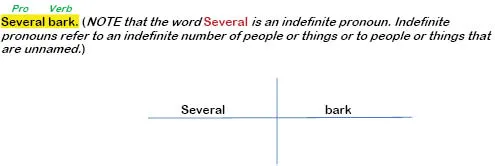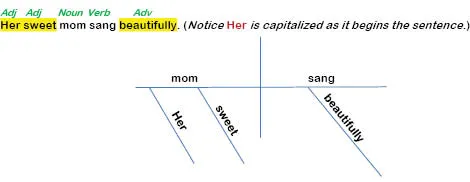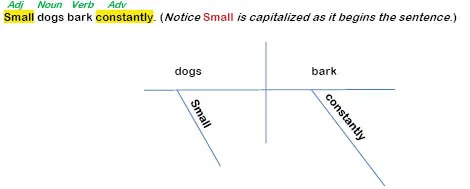
This is a test
- 98 pages
- English
- ePUB (mobile friendly)
- Available on iOS & Android
eBook - ePub
Book details
Book preview
Table of contents
Citations
About This Book
Unlock the mysteries of sentence diagramming with this simple Reed and Kellogg primer. Learners of all types can benefit from this alternative presentation of grammatical principles. Sentence diagramming aids students in seeing the connections of the words within sentences and solidifies the functions of each part in the learner's memory. Dr. Judith Coats breaks down the process step-by-step with careful explanations. The method of sentence visualization can be fun, effective, and relevant to every learner. Why not give it a try? Become a better writer by understanding the parts of the English language and how they all work together as a whole.
Frequently asked questions
At the moment all of our mobile-responsive ePub books are available to download via the app. Most of our PDFs are also available to download and we're working on making the final remaining ones downloadable now. Learn more here.
Both plans give you full access to the library and all of Perlego’s features. The only differences are the price and subscription period: With the annual plan you’ll save around 30% compared to 12 months on the monthly plan.
We are an online textbook subscription service, where you can get access to an entire online library for less than the price of a single book per month. With over 1 million books across 1000+ topics, we’ve got you covered! Learn more here.
Look out for the read-aloud symbol on your next book to see if you can listen to it. The read-aloud tool reads text aloud for you, highlighting the text as it is being read. You can pause it, speed it up and slow it down. Learn more here.
Yes, you can access A Sentence Diagramming Primer by Dr. Judith Coats in PDF and/or ePUB format, as well as other popular books in Education & Teaching Languages. We have over one million books available in our catalogue for you to explore.
Information
Topic
EducationSubtopic
Teaching LanguagesPart I
The Foundation
Subjects (Nouns) and Predicates (Verbs)
Grammatical explanation. Every sentence has two parts to be a complete sentence—a subject and a predicate, which is the portion of the sentence containing the verb.
Diagramming explanation. The baseline is the horizontal line indicating a clause or what we call a sentence. The vertical line divides the subject and the predicate evenly above and below the baseline.
The following are sample sentences:



Subjects (Pronouns) and Predicates (Verbs)
Grammatical explanation. Every sentence has two parts to be complete—a subject and a predicate, the portion of the sentence containing the verb.
Diagramming explanation. The baseline is the horizontal line indicating a clause or what we call a sentence. The vertical line divides the subject and the predicate evenly above and below the baseline.
The following are sample sentences using pronouns as subjects instead of nouns:



Adjectives and Adverbs (Modifiers or Describers)
Grammatical explanation. Subjects will be nouns or pronouns. Predicates will be verbs. However, sometimes the subjects and verbs need more description. Adjectives add description to nouns and pronouns. Adverbs add description to verbs. Adverbs add description to other parts of speech and entire sentences, but we’ll visit that concept later on. Note also that the articles a, and, and the are always adjectives. The articles limit nouns or pronouns. They are called limiting adjectives (e.g., a car, the car).
Diagramming explanation. Adjectives and adverbs modify or describe the word(s) to which they are attached. Adjectives tell us a bit more about nouns or pronouns. Adverbs tell us a bit more about verbs. Slanted lines indicate a modifying or describing function. The slant points toward the word(s) being described. When her (or other possessive pronouns) is used as a possessive adjective (as opposed to a possessive pronoun), the word is diagrammed on a slanted line under the word it is modifying because it then acts as an adjective in its usage.
The following are sample sentences:


Adverbs (Modifying or Describing Other Adjectives or Adverbs)
Grammatical explanation. Remember that we said that adverbs add description t...
Table of contents
- Part I
- Subjects (Nouns) and Predicates (Verbs)
- Subjects (Pronouns) and Predicates (Verbs)
- Adjectives and Adverbs (Modifiers or Describers)
- Adverbs (Modifying or Describing Other Adjectives or Adverbs)
- Prepositions (Prepositions Function with Other Words to Form Phrases)
- Conjunctions: The Three Types Are Coordinating, Subordinating, and Correlative
- Conjunctions: The Three Types Are Coordinating, Subordinating, and Correlative
- Interjections
- Complements: Completers of the Subject Are Predicate Nouns and Predicate Adjectives (Also Known as Predicate Nominatives and Predicate Adjectives)
- Complements: Completers of the Verb—Direct Objects and Indirect Objects
- Complements: Completers of the Direct Object (Called Objective Complements)
- Part II
- Phrases: The Prepositional Phrase (Review)
- Phrases: The Noun Phrase
- Phrases: The Verb Phrase
- The Verbal Phrase―Infinitives
- The Verbal Phrase—Gerunds
- The Verbal Phrase—Participials
- Phrases: The Appositive Phrase
- Phrases: The Absolute Phrase
- Clauses: The Adverb Clause
- Clauses: The Adjective Clause (Clauses That Contain Both a Subject and a Verb in the Group of Words)
- Clauses: The Noun Clause (Clauses That Contain Both a Subject and a Verb in the Group of Words)
- Part III
- The Simple Sentence Structure
- The Compound Sentence Structure
- The Complex Sentence Structure
- The Compound-Complex Sentence Structure
- Part IV
- An Adverbial Objective
- A Word Describing an Entire Prepositional Phrase
- Coordinate Adjectives
- A Contracted Word
- Helping Verbs Used Only Once but Implied Twice
- An Adverb Describing Two Other Adverbs
- A Compound Preposition
- Expletives (or Words That Introduce Words, Phrases, or Clauses)
- Nouns of Direct Address
- There Is, There Was as Expletive Construction
- Attributive Complements
- Phrasal Objective Complements
- Participial Objective Complements
- Infinitive Phrase as an Object of a Preposition and Having a Subject of the Infinitive
- Adjective Clause That Begins with an Elliptical Element
- That Used as an Expletive for a Dependent Clause within an Independent Clause
- Coordinate Noun Clauses as Direct Objects
- Prepositional Phrase Modifying an Adjective
- Appositive Renaming an Entire Clause
- Coordinate Prepositional Phrases
- Action Verb Normally but Acting as a Linking Verb
- Appositive Introduced by an Expletive (Introductory Word)
- An Expression of Redundancy
- Adjective Clause Introduced by a Relative Adverb Rather Than by a Relative Pronoun
- Coordinate Adjective Clauses
- Noun Clause as a Direct Object Introduced by a Split Expletive (Introductory Word)
- Elliptical Adverbial Clause of Degree and Comparison
- Appendix A
- Appendix B
- Appendix C
- Appendix D